"…in the seemingly little and insignificant things that accumulate to create a lifetime, the essence of our existence is captured." -- James Deetz
In the early 1930s, Pennsylvania and the nation were ensnared in the darkest moments of the Great Depression.
In 1931, unemployment in the Commonwealth was nearly 40 percent and in Pennsylvania’s African American community that rate soared above 50 percent.
In early 1933, the incoming Roosevelt administration began implementing a variety of public-sector programs that promised work and relief to the unemployed.
Among them was the Civilian Conservation Corps (CCC) that engaged unemployed men in reforestation, firefighting, and infrastructure work on public lands.
Now, in 2023, DCNR is working to dig into the past to uncover and preserve the stories left behind.
Segregation and the CCC
Despite the fact that the 1933 enabling legislation for the CCC banned discrimination based on “race, color, or creed”, the CCC, like most aspects of American public life in the 1930s, was racially segregated.
African American participation in the program was through enrolment in segregated companies, and in Pennsylvania it was substantial.
About nine percent of Pennsylvania CCC enrollees were African Americans, slightly higher than their proportion of the state’s population at the time.
While they received the same rate of pay, a dollar a day, the experience of African American corps members in the CCC was markedly different from that of their white counterparts.
Pennsylvania’s Segregated CCC Camps
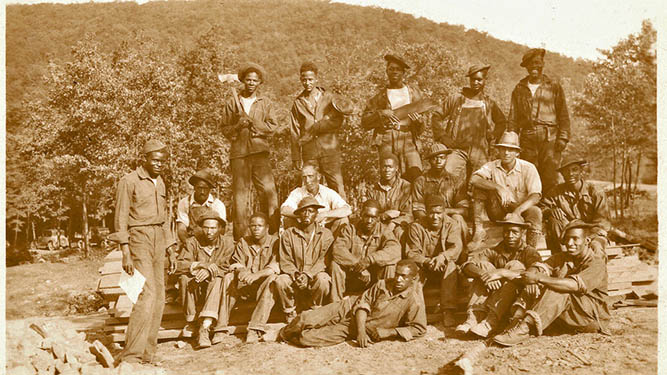
Members of CCC Company 361-C at what is now Penn-Roosevelt State Park.
In the 33 camps that included African American companies in Pennsylvania, educational opportunities were more limited than in the white camps.
The segregated units had white officers until the later days of the program, and the racism that infected American society at the time was present in many of the camps as well.
The day-to-day lives of African American corps members in Pennsylvania -- their accomplishments, experiences, and the contributions they made to the betterment of our public lands -- are very poorly documented.
The administrative record, the number of firsthand and secondary accounts, and the photographic record is simply not as extensive as it is for the white companies.
This leaves archaeology as one of the best and only ways to tell the story of these young men.
Telling the Segregated CCC Story in Pennsylvania State Parks
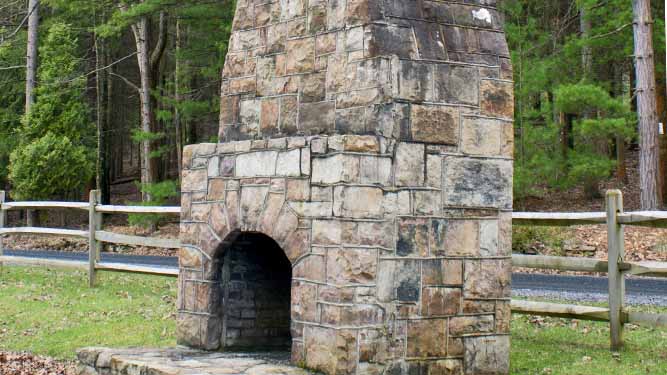
The stone fireplace and chimney from the Penn-Roosevelt camp's recreation hall.
In 2022, DCNR’s new cultural resources program took the first steps to help fill in the missing parts of the story of the segregated CCC in Pennsylvania.
The Pennsylvania Outdoor Corps Cultural Resources Crew conducted multi-week projects at the sites of segregated CCC camps at Penn-Roosevelt and Pymatuning state parks.
These are the first efforts at what are anticipated to be multi-year projects, but the preliminary results are already beginning to open a window into the untold stories of life at the camps.
The CCC at Penn-Roosevelt State Park
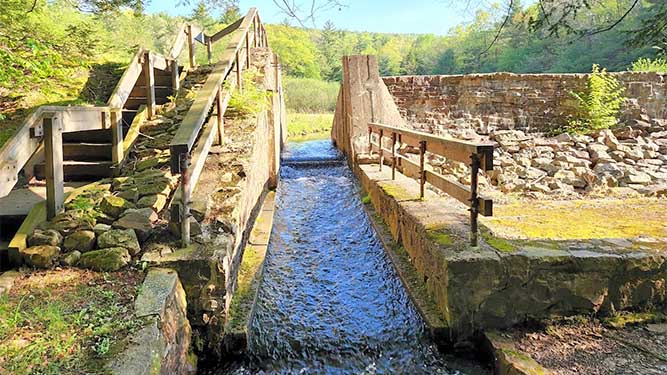
CCC workers constructed the dam, pavilions, and other facilities at Penn-Roosevelt State Park.
Penn-Roosevelt, in Centre County, was the home of Company 361-C between 1933 and 1935.
The company was primarily engaged in reforestation projects and in firefighting in what is still one of the most remote and wild parts of the Seven Mountains region of central Pennsylvania.
The research focus at Penn Roosevelt was on beginning an extensive metal detecting survey of part of the camp’s barracks and parade ground area, and the results were encouraging.
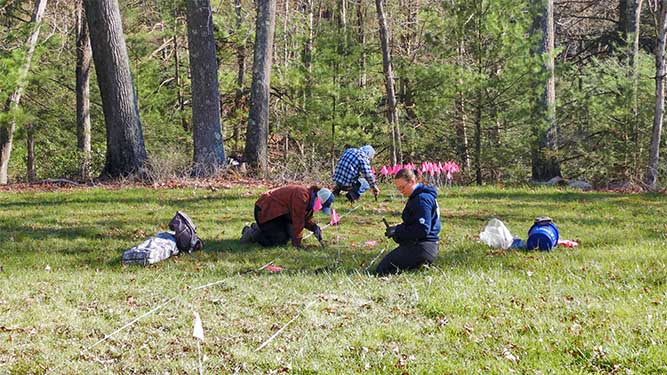
The Cultural Resources Crew surveying the former barracks site at Penn-Roosevelt State Park.
After abandonment, many CCC camp sites were re-used with the resulting post-camp disturbance obscuring or obliterating the record of life in the camp. That does not appear to be the case at Penn-Roosevelt.
In addition to lots of construction debris (primarily nails), the 2022 project at Penn-Roosevelt produced substantial evidence of daily life in the camp barracks.
The metal detectors recovered:
- Uniform buttons
- A boot clasp
- The brass plate from a shower or sink drain
- A government-issue toothpaste tube
- A spring from a corps members cot
- Other small items
Each of these objects tells us something about the young men who built and lived in the barracks, and as analysis continues, they’ll reveal more details of their lives in the wilds of the Seven Mountains.
Pymatuning State Park and the CCC
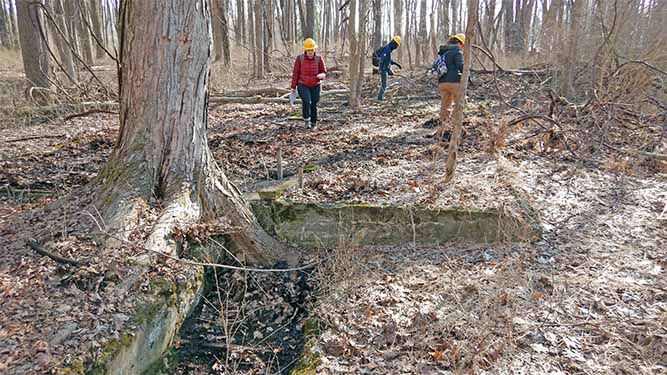
The Cultural Resources Crew surveys the former site of the Pymatuning Reservoir CCC camp.
At Pymatuning State Park, in Crawford County, Company 2312-C occupied the Pymatuning Reservoir Camp from 1935 to 1938.
The company worked on reforestation, roads, trails, structures, and firefighting, and they also engaged in emergency relief and rescue work in Pittsburgh and Johnstown following the devastating 1936 floods.
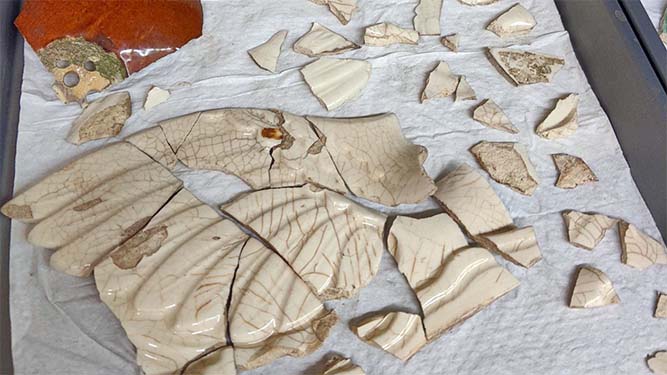
Shards of a swan-patterned flowerpot found at the Pymatuning CCC site.
The 2023 research focus at Pymatuning was on the basic mapping of the visible evidence of the camp and some very limited test excavation.
As at Penn-Roosevelt, the Cultural Resources Crew found undisturbed evidence of life in the camp.
This included several period middens -- or trash dumps. Among the artifacts recovered from a small sample of one of the dumps were some surprising items including:
- A swan-pattern flowerpot
- Fragments of a ruby red glass pitcher and a poinsettia pattern juice glass
- Most remarkably, two nail polish bottles
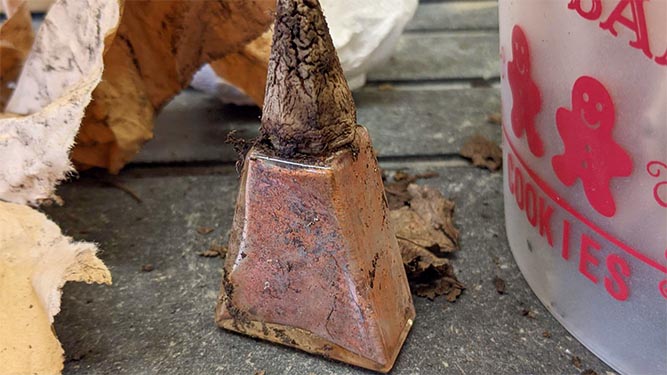
One of the nail polish bottles found at the Pymatuning CCC site.
The nail polish particularly indicates there were almost certainly female visitors to the camp.
Background research indicated that the camp hosted regular dances, and the corps members frequented local communities.
Continued archaeological work at the Pymatuning Reservoir Camp may ultimately be able to help provide a more complete picture of the interactions between the young corps members and the surrounding communities of rural Crawford County.
A Plan to Preserve and Interpret the Past
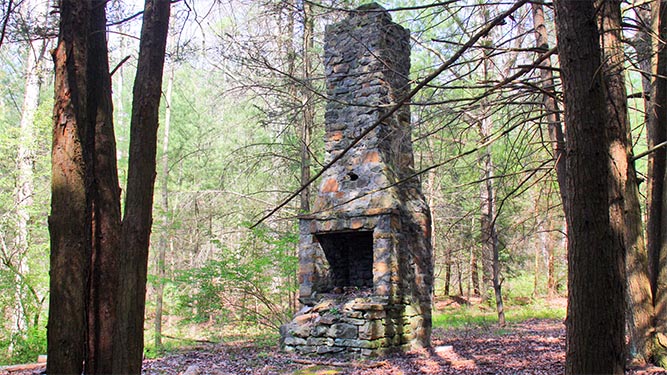
CCC ruins at the Sideling Hill Tract of Buchanan State Forest.
As DCNR’s research initiative into the segregated CCC continues, there are several important goals, including:
- Development of more complete documentary contexts, public education, and interpretation through additional research at the National Archives and other repositories.
- Expanded archaeological testing at both Penn-Roosevelt and Pymatuning state parks.
- Identification and mapping of the other segregated camps on DCNR lands.
- Locating and developing oral histories with members of the descendant community of segregated CCC corps members.
- Developing best practices and policy to guide the future management, study, and interpretation of DCNR-owned segregated CCC sites.
If you or anyone you know had family members who were enrolled in any of the segregated CCC companies in Pennsylvania and you would be willing to share family stories or memorabilia, please contact DCNR’s Cultural Resources Coordinator
Angela Jaillet-Wentling.
DCNR encourages visitors to appreciate and contemplate the evidence of our predecessors you may see around you, with a reminder not to damage that evidence.
Removing artifacts or disturbing, defacing, or damaging historic places on state lands is prohibited by law and robs all Pennsylvanians of part of our history.
Report any discoveries to state park or forest staff and take only memories and photographs with you. Help us preserve this important and mostly untold story of Pennsylvania’s public lands for future generations!